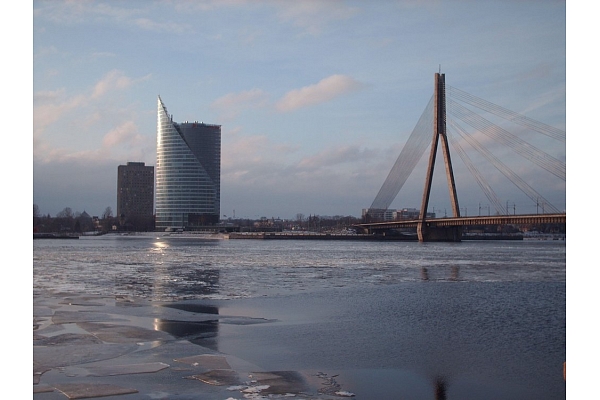External trade of Latvia
Latvian exports: Running ever faster
Latvia’s export of goods in 2011 showed the highest volumes in six years and one of the fastest export growth rates in the European Union (EU) for the second year in a row. Experts compare this to a fast sprint that will get even faster in 2012.
* Exports in 2011 totaled EUR 8,6 billion which compared to 2010, increased by 28,1% or EUR 1,88 billion.
* Exports grew in 2011 not only quantitatively, but also improved in quality. The proportion of technology-intensive and high value-added goods has increased.
* The pace of import growth was somewhat higher than the growth of exports (+28,3% or +EUR 2,4 billion compared
to 2010). The faster growth of imports in relation to exports has increased the foreign trade deficit by 29% to EUR 2,25 billion. While the foreign trade deficit has grown, it is linked to a rise in capital goods imports, which create the possibility of increasing manufacturing capacity and competitiveness, thereby contributing to export growth in the future.
Most important trading partners
* Improved competitiveness, a favorable cost dynamic and an increase in foreign demand, that was pronounced at the beginning of 2011, allowed Latvian manufacturers to maintain and expand export market shares not only in the most significant trading partners’ markets, but also to conquer new market niches.
* As for several previous years, Latvia’s main export and import trading partners in 2011 were the European Union countries – with 72,4% and 76,4% of total volume, respectively. The Baltic countries, the Nordic countries and Germany, which among the large Eurozone countries is Latvia’s most important trading partner, all contributed significantly to the growth of exports in 2011. Lithuania and Estonia’s shares of Latvia’s total exports rose in 2011, and the export of goods to Poland increased significantly. A considerable volume of exports went to Afghanistan, which, most probably, will be connected to the transit of non-military cargos to the country through Latvia.
* Latvian exporters in 2011 did not yet feel the effects of the European debt crisis, because Latvia’s exports to the problematic Eurozone countries: Portugal, Ireland, Italy, Spain and Greece comprise a small part (2%) of the total.
Imports and exports by kinds of goods
* Latvia’s exports by sectors of industry have become more diversified and there have been changes in the composition of exports during the year. As in previous years, the largest exports have been of wood and wood products, as well as of food and agricultural products, but the relative weight of these product groups in Latvia’s total exports has declined.
* Export growth was registered in 2011 in all significant groups of goods. The total growth of Latvia’s exports in 2011 was provided by five main groups of goods, the largest of which was metals and mineral products, which comprised more than a third of the total export growth.
* A significant part of export growth also comprised agricultural and food products, products of the chemical industry and wood and wood products. Together these five groups of foods accounted for 2/3 of all Latvian exports and provided 70% of total export growth.
* Historically, a large part of Latvia’s imports is comprised of energy resource.
* In addition to consumer goods, a significant role in imports was played by the need of the export sector for raw materials and capital goods imports – the import of machinery and equipment to meet Latvia’s need for revamping its manufacturing capacity.
* The natural gas company Latvijas gāze, the petroleum products wholesaler Mažeiķu nafta, the food and consumer goods retailers Rimi Latvia and Maxima Latvia have for a long time been among the largest importing companies. (Read about Latvia’s largest export enterprises on page 38-41).
Forecasts
* The growth of exports was the main driver of Latvia’s economic recover in 2010–2011, and will not lose its significance in 2012. Since many manufacturers of export goods have reached maximum production capacity, there will be an increasing role for investments by companies in increasing production capacity.
* Export growth in 2012 will depend on events in Europe, which is an essential export market for Latvia and where there is great uncertainty about developments and solving the debt crisis, as well as forecasts of a recession in 2012.
* The Bank of Latvia points out that, with the weakening of demand in external markets, there will be an increase in competition and a greater significance for the quality of Latvian export goods, That means that proportion of goods based on the intensive use of technology and with high value added in Latvia’s export structure must be gradually increased.
* It is forecast that the rate of export growth will decrease in 2012, but since countries directly affected by the Eurozone debt crisis are not among Latvia’s largest trading partners, a sharp decrease is not expected. The Ministry of Economics forecasts export growth
in 2012 of 3–5%.
Useful facts:
* Presently there are 12 external Representative Offices (located in Germany, Great Britain, Sweden, France, Russian, the Netherlands, Denmark, Norway, Japan, Poland, Lithuania and the Ukraine) at 35 Latvian embassies, which are a significant instrument of support for exporters abroad. Soon, a Representative Office will start work in China. In 2011, it was planned to open a Representative Office
in Belarus, which will depend on developments in relations between the EU and Belarus.
* In countries where there are no Representative Offices, employees of the Latvian Embassy provide export support for enterprises.
* In the future, it is planned to expand Latvia’s Representative Offices to such BRICS countries as China, Brazil and India.
* Merchants can apply for the status of recognized merchant which permits them to use advantages and simplifications during settling the customs formalities in any EU member state according to the type of certificate received.
Useful links
Central Statistical Bureau – www.csb.gov.lv
State Revenue Service of Latvia – www.vid.gov.lv
Investment and Development Agency of Latvia – www.liaa.gov.lv
Ministry of Economics of Latvia – www.em.gov.lv
Register of Latvian companies legal and contact data – www.firmas.lv
Photo: Stock.XCHNG





